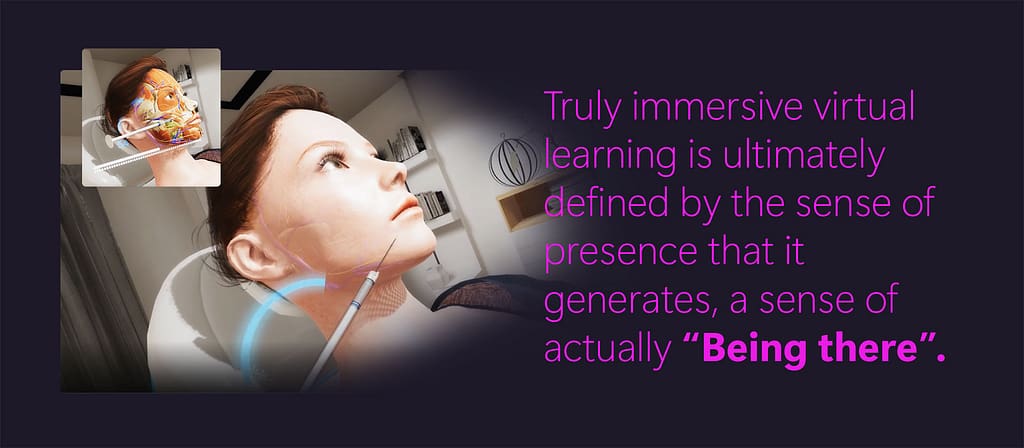The Future of Life Sciences Training
THE FUTURE IS NOW
The future of Life Science training hinges on several very recent developments in immersive learning and other related modalities which have greatly affected the viability of fully immersive virtual reality training programs that are changing the landscape of training forever. In this article we will discuss the science and evidence behind why immersive training in healthcare is so effective, what has changed, why it matters, and how to take advantage of new trends that are paving the way for better training and ultimately better patient outcomes.
Immersive Learning is the culmination of decades of learning science about how to simulate and prepare a user for the “real thing” through simulation. With hardware, software, and cost finally coming into alignment for the coming wave of change, creativity is the only limiting factor in building something impactful.
Immersive learning is arguably as good as it gets in helping a learner quickly and efficiently build a mental model of a complex subject. Starting with the foundation of “learning from experience”, and combining just-in-time and in-context guides, your learners can engage with virtual scenarios on their schedule and without regard to their geographic location. Immersive learning can bring teams together and be the gold standard solution to your training program where time-to-train timelines and budgets are major constraints.
So what is Immersive Learning? Immersive learning is any training experience that fully engages a learner’s senses. Utilizing sight, sound, touch and interaction, and especially movement. Even invoking stress, fear, excitement and reward by eliciting emotional responses, when done properly, Immersive learning has the potential to be the most potent methodology and the gold-standard for learning. That being said, Immersive learning isn’t something to be thrown around lightly, it is not something that makes sense for all training applications, but where deeper retention is critical, or a human element enhances the user’s mindset for learning, immersive learning is as powerful as it gets.
An experience can be as simple as a 3D animation that the learner interacts with to simulate a complex concept, or even a 360 video that puts the viewer in the middle of a film where they can look around in all directions, both can be great starts in the direction of immersive learning, but for this article, we are talking more specifically about an augmented or virtual training experience that utilizes six degrees of movement, movement that responds not only to the direction of the users view, but movement that allows the user to actual walk around in the space and interact with objects in 3D. Although there are a few forms of this type of interaction, the easiest and most prolific example of Immersive Learning is Virtual Reality, where a user wears a headset and is taken to another location entirely.
SALES TRAINING AND CLINICAL EDUCATION IS CHANGING
Virtual immersive learning is quickly being adopted across all of medical device, pharma, and diagnostics, because of its ability for users to LEARN FROM EXPERIENCE in a virtual environment without the costs and time-constraints involved with actual on-site training.
Additionally, the pace of change in the healthcare industry has greatly increased over the last 20 years. With an aging population, the complexities of a more digital and distributed workforce, and increasing and expanding ranges of treatment options, There has never been more pressure on learning and development teams to be stretched further and provide more efficient outcomes.
Simulation is increasingly becoming a cornerstone of high-value sales training and clinical education. With increasing pressures on budgets, and a vastly changing landscape, finding a better and more reproducible model for training is critical. Standardized, repeatable, and analytics-creating methods add powerful levels of insight to the return that you are getting on training programs. And with so much of today’s workforces becoming more and more virtual and remote, its more critical than ever that methods that greatly increase knowledge transfer are looked at very closely.
We need to adapt how we are preparing future reps and clinicians. It is no longer enough to simply focus on their ability to retain facts and information, we need to be able to train them and evaluate them on how they apply that knowledge in specific situations. Because of this need for learners to be more adaptable and flexible, there is a monumental move to get away from rote learning and move toward more clinically relevant problem-solving, communication, and skills-based training. These difficult requirements are helping experiential immersive learning gain momentum in all areas of enterprise training and marketing.
Virtual training is not new, but it has been an expensive proposition for many training organizations for many years. Fortunately, with todays hardware like the Meta Quest 2 or the Pico 4, a full 6DOF (Six degrees of freedom) experience is now attainable on scale, with costs rivaling the expense of a new office chair for an employee. With the technologies finally affordable at scale and at a flexion point toward massive value and positive return on investment, the market is quickly shifting toward investing in more immersive and engaging training programs. When it comes to measurable training results, ROI is a better indicator of value than cost, and immersive learning opens many avenues for collecting valuable data that can prove ROI.
Why does Immersive learning matter?
According to studies, this form of learning can be almost 6 times faster than traditional learning. It also reduces risk, allowing learners to train and practice more regularly with conditions that were previously only possible in real-world scenarios.
Many organizations utilize proctoring or shadowing as effective ways to build opportunities for experts to mentor and engage trainees. This is highly affective as it engages the senses and emotions of the learners, but many organizations struggle with scalability of human-lead training programs, especially with high turnover areas like sales rep training where taking time from expert “doers” to teach can be compounded by the nature of needing to repeat the time commitment to in-person training over and over through onboarding and attrition. Immersive learning experiences are scalable and cost-effective by allowing a very similar “in-person” training experience to take place at any time, regardless of geographic barriers, and with the ability to scale and adapt through learning outcomes and analytics.
With many enterprise organizations more geographically dispersed than ever before, implementing immersive digital training experiences is becoming more and more critical in keeping workforces knowledgeable and up to date with the latest skills and knowledge they require.
An additional layer of efficiency can come from integrating user analytics data to track competency and overall training results. With real-time feedback and engagement data, experiences can be updated and adjusted on the fly to keep the learning experiences fresh and effective through real results. Tracking user interactions and achievements can be done invisibly within the course itself, where the users don’t actually feel they are being “tested” with traditional methods, giving a less biased insight into a user’s true performance. Yet, if still needed, inserting traditional course training within the experience can also be done, giving you the best of both worlds by gathering the data in one place and time.
At the end of the day, the overall guided purpose of the life science industry is to increase patient outcomes. Anytime knowledge gets transferred to a sales rep, or a clinician, a physician or a patient, the purpose is to increase patient outcomes or to lower costs…Both of which ultimately leads to getting better healthcare solutions to as many people as possible. Focusing on accelerating the transfer of knowledge isn’t just good for budgets, its good for everybody.
3D objects and elements are the foundation of effective immersive experiences, and having a firm grasp on framing, contrast, resolution, lighting, and many other considerations are critical to building an effective immersive learning experience. Spatial considerations and a broad understanding of how to mentally and emotionally engage a learner is critical. There are many aspects to immersive learning, and especially virtual reality where if you don’t get it right, it matters a lot. For instance, making sure that an experience can run at a 90hz or higher framerate is critical to how the human brain interprets spatial movement in an environment. Although 60hz is considered an acceptable baseline, you risk making a user dizzy when the environment doesn’t track at the speed that the brain expects, leading to a feeling of un-ease that can be distracting to the learning experience.
Having intuitive learning interactions is also critical, immersive training done correctly relies on real-world interactions to reinforce learning. Having a user interact with an object directly where possible, vs clicking a “Next” button requires a different mindset from traditional page-turner training courses. A poor user experience is currently the biggest adoption barrier with polling data from training teams, so finding a team with experience is critical. Getting it right makes a big difference in outcomes.
The brain learns by increasing connected pathways, immersive learning provides an element of emotional connection that the brain accepts as “real”. With 6 degrees of movement, the brain can’t help but believe what it is seeing is real, and it responds accordingly. This creates perceptual fidelity, activating the same neural pathways as the real activity. This stimulation of the brain invokes real emotional response, which makes learning much more vivid and memorable. Additional emotional and intellectual responses like stress and excitement are also available and magnify the stimulation for greater learning.
Traditional methods of learning are all methods to try and simulate the “real thing” best that it can, or it at least tries to PREPARE the learner for the real thing that is yet to come in their training. When a learner experiences a simulation within a virtual reality experience, the safety to all participants is automatic and failed outcomes isn’t detrimental to learning. The learner can more quickly be given increasingly difficult educational tasks that would be costly or dangerous in the real world, allowing the user to build those mental models of DOING, not just PREPARING TO DO, much much sooner. This doesn’t simply lead to quicker time-to-train returns on your training investments, it also brings much better learning outcomes than rote methods of simple memorization or even more engaging traditional training methods.
The brain releases dopamine with positive and emotional feedback. This feedback mechanism is central to learning and rarely engaged in traditional digital learning methods. These neurochemical feedback mechanisms can be tapped into and brought to the forefront of learning to reinforce neural pathways in the brain, leading to a much faster transfer of knowledge.
In recent studies on virtual reality training, over 95% of VR training participants feel that it is superior to any other training method, and in post-training exit polling, over 80% of participants felt ready for similar real-world experiences after hands-on VR training. This makes sense because they feel like they have already “Done it”…and, well, they have to a large degree!
Retention is ultimately the name of the game when it comes to training, and with immersive VR training, studies show that VR training has a learning retention rate of over 75% compared to 20% with traditional mixed-media. That’s nearly a 4x return on your knowledge transfer investment compared to more traditional methods that take more time, more content, and ultimately, more failed scenarios post-training due to poor readiness. In healthcare, real-world failure is rarely a minor consideration, it’s a huge problem, and a costly one!
How can I take advantage of this shift in training?
Virtual Immersive Learning programs are quickly becoming THE powerful education tool for learning objectives and its growing worldwide fast!
Adoption is a big barrier to any technology, and the hardware adoption statistics are trending positive, and quickly. Since 2019, the number of VR users has more than doubled, and the number of AR users has nearly tripled! Today, there are over 170 Million VR headsets being used!
In 2022, over 75% of companies that implemented large-scale VR and AR training technologies saw a 10% increase in operations. These initiatives result in millions or hundreds of millions of dollars that these companies are saving or earning, and Life Sciences leads all sectors in VR and AR training adoption, so there are a lot of great examples of effective programs being deployed.
A great start is knowing which parts of your existing programs would benefit from immersive technologies. You can start evaluating internally without involving any vendors. Make a list of all your top priorities and existing programs and highlight areas where a human element is critical, or an emotional element, or any place where a hands-on approach would bring much more effective outcomes, and look at those first as possible pilot opportunities.
It may not be feasible to shift your entire training program over to virtual, but even taking a first step by finding a highly valuable part of your training program and making an immersive pre-trainer, or a small pilot with a tangible and measurable part of your curriculum would be a great place to start and see if immersive techniques might be more broadly applied as you go.
Reach out to your existing training partner and get some examples of projects that they have done with similar clients and specifically talk with them about the ROI that those groups have seen. Don’t spend valuable budget on immersive virtual reality training simply because it is the “cool new thing”, it’s far more important to try to tie your initiative to ROI metrics up front when you can, doing so can allow your immersive learning partner to help find ways to build in areas to measure that ROI as they plan your project.
Get a great team if you don’t already have one!
Many large and small corporations are embracing immersive learning as the most effective way to train their teams on mission-critical information that needs to be absorbed quickly, and a properly designed and built experience can be game changing for learner engagement and for outcomes. It really gets learners in the driver’s seat of learning by DOING.
Its critical to work with a group that can interface with your experts, SME’s and key opinion leaders to co-mingle ideas around your objectives and outcomes. It is a fluid and a massively creative endeavor that requires all of the disciplines of great training to pull off a great project. Everyone from the instructional design team to creative directors, software developers, 3D animators, and VR coding experts need to work in concert to pull off a beautiful program that engages learners in meaningful ways, focused on real learning outcomes.
Utilizing immersive learning technologies just might be the way to uplevel your training initiatives this year, with a great plan and a great team, you can expect huge results that are worth every penny spent!
Blog Categories
- Company News (33)
- Healthcare Operations (1)
- Industry News (19)
- Sales Enablement (1)
- Software Publishers (1)
- Virtual/Augmented Reality (2)












